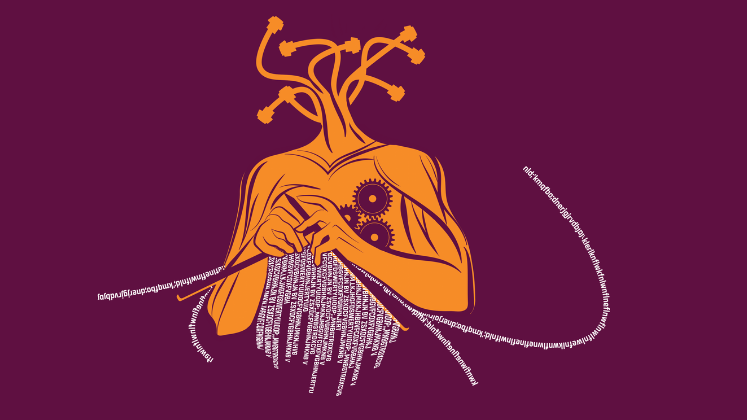Drawing on their experience of designing higher education courses centred on AI tools, Bert Verhoeven and Vishal Rana discuss how, rather than being a threat, AI can be used in ways that are compatible with traditional teaching methodologies and offer a golden opportunity to make course design learner centric.
The ability of Large Language Models (LLMs), like ChatGPT4, BingChat, and Bard, to undertake a variety of tasks from data storage, query responses, to the generation of essays, reports, academic papers, policies, feedback, strategies, legal documentation, and coding, poses questions for how we value this kind of knowledge work and how, as educators, we approach teaching these skills. Whilst some have argued for a return to an imagined analogue past, we argue it is time to re-think our curriculum, pedagogical methodologies, and assessment approaches with a focus on the user of AI as a learning tool.
User driven models are experiential and deploy authentic assessment methods, designed to evaluate students’ skills and competencies in real-world contexts. Such active learning approaches tend to be less vulnerable to cheating, because they require engagement and authentic problem-solving, which are difficult to outsource to AI (for now). They are also a student focused and labour-intensive model, with for example class discussions, workshops, project work and continuous share-and-feedback presentations. They are opposed to the traditional academic model of teaching through knowledge transfer at high-level lectures and tutorials.
User driven models are experiential and deploy authentic assessment methods, designed to evaluate students’ skills and competencies in real-world contexts.
However, the history of innovation shows that change can be delayed by powerful incumbents, like big universities. For example, in 1984 Benjamin S. Bloom and his team found that when a student is tutored one-to-one using coaching techniques which enable them to actively explore, co-create and apply knowledge, they performed two standard deviations better than students who were taught in a traditional, one-to-many lecture tutorial. Four decades of peer reviewed research later there is conclusive confirmation that 98% of students will achieve significantly better outcomes following these methods, than those who are taught in a traditional classroom. Yet, lecture-tutorial is still the most used form of pedagogy in higher education.
A recent study found that out of the top 25 roles that will be most impacted by AI, 18 (72%) are educator roles. This is unsurprising as AI may help educators to automate many labour-intensive and repetitive tasks. By liberating educators from monotonous tasks, AI could enable educators to re-channel their energy towards nurturing the most precious resource – students. One avenue this could take would be to adopt the principles of Flipped Learning 4.0. This kind of assessment framework would emphasise the evaluation of students’ aptitude to research, discern, and critically dissect factual information and to use AI as a tool to achieve this. It would also mirror an emerging shift in the role of knowledge workers from Creators, Managers and Administrators to Co-creators, Editors and Facilitators and demand for higher-order problem solving, co-creation and critical thinking skills. AI disruption may present an opportunity to shift the focus from assessment of learning to assessment for learning. Here’s a step by step guide we found helpful to get started.
By liberating educators from monotonous tasks, AI could enable educators to re-channel their energy towards nurturing the most precious resource – students.
Taken together these models can help graduates prepare for new roles and meaningful work. It seems to us that this new design should aim at roles for AI in (1) automating routine tasks, (2) providing actionable insights, (3) supporting the creative process, (4) aiding in data analysis and decision-making.
Concurrently, human tasks should be redesigned around (1) providing contextual understanding (prompt engineering), (2) editing the AI output, (3) facilitating creativity and innovation to achieve impact, and (3) deploying interpersonal skills leading to collaboration, synergy, and serendipity. We think this can be distilled into five rubrics for AI oriented education:
- Orientation: This emphasises fostering a growth mindset and empathy within learners to motivate and foster a user driven approach in co-creation with AI tools.
- Engagement: Here, we focus on encouraging experimentation, collaboration, co-creation, and effective communication for the role of editor and co-creator with AI as a co-pilot/adjunct.
- Knowledge and Skills development: This pertains to the learners’ ability to recall and understand core concepts, and ability to apply methods/tools in for example cases and exercises.
- AI Integration and Ethical Use: This prepares students for thoughtful, ethical, and appropriate use of AI. It includes the ability to correctly prompt, assess, validate and provide evidence of the ethical input and output of AI tools, where appropriate. This purposeful integration of AI improves quality of student outcomes in several areas.
- Facilitation and Real-World Application: In this stage students learn how to facilitate implementation of AI tools and other concepts in an authentic, real-world application, reflect, and design learning strategies to get better. Students work in groups on real world ventures or projects, depending on the specific academic field. Assessment is for helping develop learners’ strategies for implementing knowledge and AI tools in real-world situations, encouraging self-reflection.
Elements 1,2,4 and 5 are agnostic and can be used in any course to develop knowledge and ability (competencies) necessary for the new meaningful roles of knowledge workers. Stage 3 is discipline specific and could be measured by a supervised exam, or in-class essay. But better would be to use flipped classroom with for example Tedtalk-style videos and quizzes where students acquire the knowledge before class. Then practice methods and tools in class, with formative feedback and coaching to prepare students for real world application. Here students apply the knowledge and train to become better at it.
Faster horses
When asked about consumer input into his business Henry Ford famously replied: “If I had asked people what they wanted, they would have said faster horses.”
Based on our experience integrating AI as a learning tool into our Innovation and Enterprise course, we pose that the essence of our argument is this: we must move beyond the mindset of viewing AI as a threatening storm on the horizon. AI is now a part of our reality and has the potential to be a remarkable ally, amplifying human potential in a symbiotic relationship. The question we need to ask ourselves, how can we prepare for a future that is likely to be closely intertwined with AI without simply imagining faster horses.
The content generated on this blog is for information purposes only. This Article gives the views and opinions of the authors and does not reflect the views and opinions of the Impact of Social Science blog (the blog), nor of the London School of Economics and Political Science. Please review our comments policy if you have any concerns on posting a comment below.
Image Credit: Google Deepmind via Unsplash.








Great, succinct blog post! It would be great if we could go deeper and unpack some more concepts around the five rubrics presented.